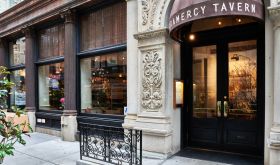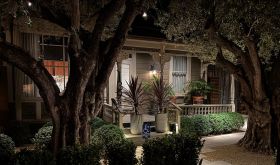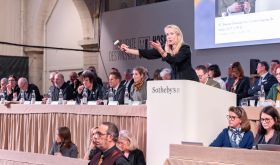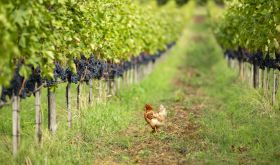Robbie Bargh bounded into The Bar at The Dorchester Hotel on Park Lane wearing silver trainers and black trousers with a white skull and cross bone pattern on them, greeted me warmly but immediately addressed himself to its manager. “Please turn the lighting down straight away. It’s too bright and it’s making everybody in here look far too old, including me”, he said.
The manager promptly did what he was told and then led us both through the crowded bar to the table he had reserved for us. Bargh settled back on the banquette and looked around him, “That’s better. You can see the silhouettes on the ceiling now. Everybody feels better in this subdued lighting, which means they may well want to stay for another drink.”
Bargh speaks with confidence and experience because over the past decade he has established himself and his company, The Gorgeous Group (so called because of his late grandmother’s nickname for him), as the leading experts and consultants on bars. Previous clients include The Dorchester and Hakkasan, where the Hakka, the Red Dragon and the pink mojito, the three drinks he created for its opening, are still very popular. Current projects include new identities for the American and Beaufort bars due to open in The Savoy next year, while he and his staff of 13 are also involved in bar projects as far afield as Dubai, Sofia and Port Elizabeth in South Africa.
These are all a long way from the council estate in Manchester where Bargh grew up, his imagination lit at an obviously impressionable age by the glamorous films of Busby Berkeley. He was 16 before he ate in his first restaurant, but then he came to London to work in a very busy but unglamorous hotel under the direction of an extremely well-organised female food and beverage manager, to whom, he believes, he still owes a huge debt of gratitude. Only then did he begin to channel into bars his enthusiasm for brightening up people's lives.
We had agreed to meet for a high-class bar crawl. After The Dorchester we would move on to Duke’s Hotel, famous for its martinis (although Baugh is critical of their habit of topping up your drink from the shaker as a glass is already mighty strong), before experiencing the modern side of cocktails at the Salon Bar above L’Atelier du Robuchon. Finally, there would be a bite to eat at Kettner’s, which has just re-opened in Soho with a new champagne bar.
But before divulging any secrets, Bargh needed a drink and promptly ordered a Negrone, that classic, potent, Italian combination of gin,Campari and sweet vermouth, topped off with strained fresh orange juice. He seemed pleased with what he was served as the drink came in a heavy glass, with what he described as ‘proper, large ice cubes’, a good stirrer and a slice of orange zest at the top. With plump olives and salted cashews it encapsulated what today cocktails embody for Bargh. “They’re a bit of luxury and you don’t have to be a jet-setter to enjoy this bit of the jet-set life.”
Although at £18 a drink as they are here, these cocktails can be very profitable and not just for Bargh. He began by explaining that in his experience hoteliers were often scared of developing their bars perhaps because 80% of the bar’s customers tend to come from outside the hotel. Yet a busy bar can be the third most profitable sector in any hotel, after the rooms and banqueting, invariably more profitable than the often far more publicised restaurant.
But to be successful, a bar must incorporate two critical ingredients, in Bargh’s opinion. “The key to the drinks list is customisation. It’s not only mixing the classic cocktails correctly every time but also creating new ones which aren’t silly but are closely connected to what the hotel or restaurant stands for and increasingly the style of the food it serves. The second is training all the staff, of empowering the barman not just to mix the drinks but also to learn from his guests. People want to be able to connect with one another but this is less easy in a bar than in a restaurant because the guests tend not to stay for as long.” As we were needlessly interrupted by a waiter wanting to know whether we were enjoying our drinks, he added, “And, just as importantly, they have got to know when to back off, to leave the customer alone. Bars are also about solitude, where those who want to can come in, sit comfortably and take it all in.”
Bargh aims to achieve this professionally with a team that incorporates drinks experts, obviously, who help him customise the cocktail lists but also two chefs, currently working together on a project that will combine a bar with Bombay street food. And most widely called in are his cadre of trainers, who not only instruct a bar's staff but also visit bars as mystery shoppers and, most importantly in Bargh’s opinion, turn up unexpectedly in the early hours of the morning. “What happens at 2am when the bar is closing down has to be handled as professionally as when customers are being served at 8.30pm”, he explained.
This less than glamorous side is mirrored by Bargh’s fastidious approach to staying fit in a world of alcohol. “I have never smoked nor used drugs, I cycle and swim a lot, and next year I hope to run another two marathons in London and New York”, he confessed.
Despite all this training, I was able to keep up with Bargh as he walked briskly to Duke’s Hotel in St James’s, where we arrived too late for the table he had reserved, and then on to the top floor of L’Atelier du Robuchon in Covent Garden. Esconced in a red leather chair in the corner and with a very different cocktail in front of him, this time a pomegranate Martini alongside a shot glass of champagne granita served on a long white plate, Bargh turned philosophical.“I suppose that what we strive to do every day is what anybody does at home when they have a party. Get the food, music, drink and lighting right so that everyone can have a good time.”
He followed this up with several tips on how to make the best cocktails at home this Christmas, which involved not necessarily investing in the most expensive spirits (he is a great fan of Waitrose own-label gin, for instance) but instead by concentrating on those elements which will really make a noticeable difference to the drink. These include great Angastura bitters (The Dorchester has three different flavours, cardamom, chocolate and ginger); fresh limes and lemons, big ice cube mould, and top quality mixers, perhaps something unusual like pink grapefruit juice. All of these should have the benefit of some pristine but basic bar equipment such as a really good shaker and strainer. And, last but not least, a fresh bottle of Noilly Prat.
With all these, Bargh would ask you to add just a dash of your own imagination to customise your drinks. “Punch is always a popular drink at this time of the year and one of the most memorable punches I ever drank was when the host simply served it in an egg cup.”
Here is his recipe:
Winter Julep Gorgeous Punch
Serves 3-5.
Organic Mint Tea 800 ml
Brown sugar 50 ml
Bourbon 350ml
Cinnamon 2 pinches
Warm through, finish with orange zest, sprig of mint and a cinnamon stick. Serve as small portions in brandy balloons.













